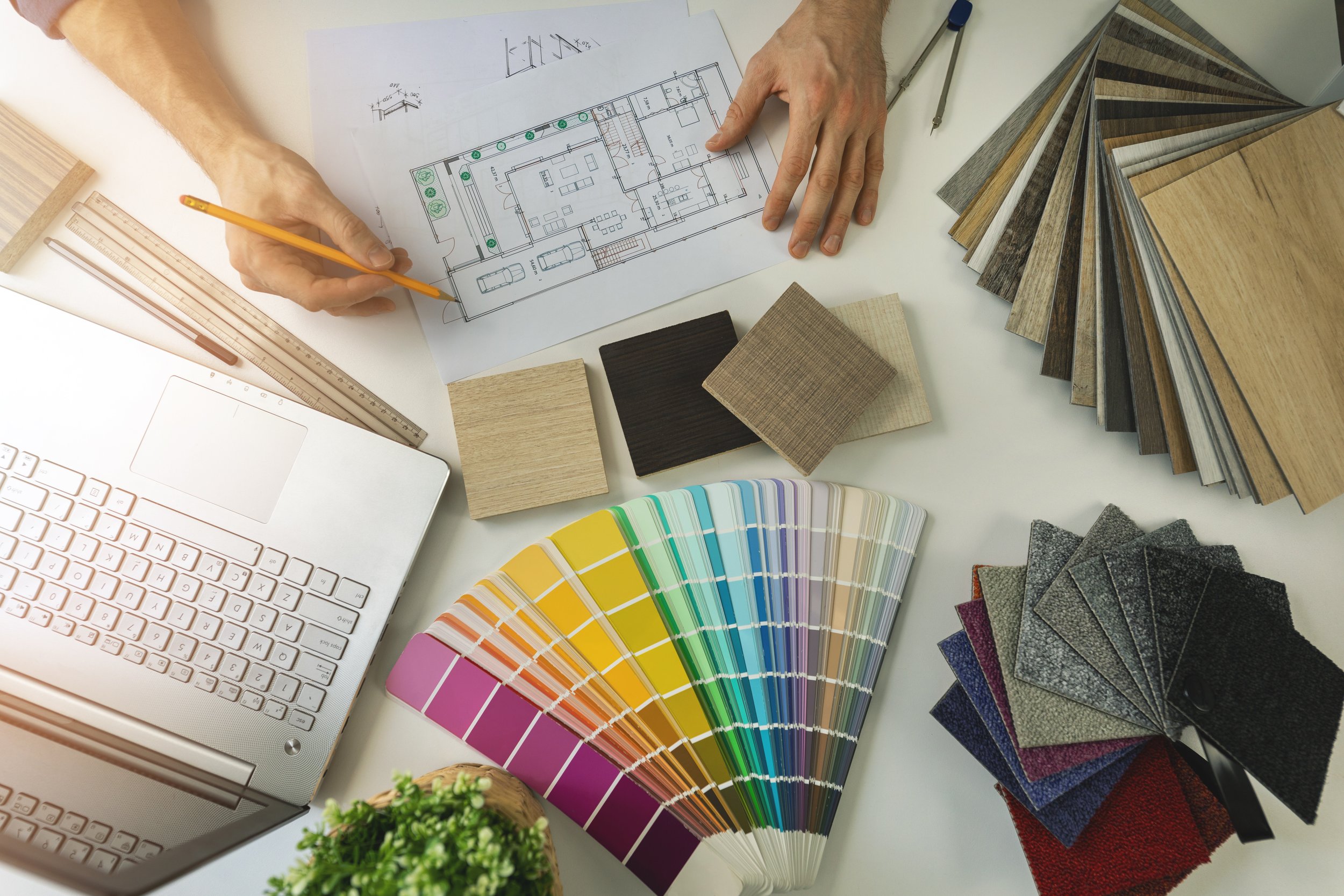Copyright for Interior Design: The Essential Guide to Protecting Interior Design Projects
Interior designers often understand the importance of copyright protection but may not be fully aware of the best strategies. By owning and controlling their copyright, designers can license their work for profit, prevent unauthorized use, build their reputation, and maintain their creative integrity. This guide will help interior design professionals become copyright savvy and protect their intellectual property with a few easy “best practices.”
In this guide, we will explore:
the concept of copyright and how it works in the interior design context,
best practices for protecting interior design projects, and
how to deal with unauthorized copying.
Note: While this guide won’t cover all the legal intricacies and nuances of copyright law in the United States, it will cover the essentials that interior designers need to protect their work and their business.
What is Copyright?
Copyright is a legal right that shields the creator of an original work from others using it without permission. It covers various creative works like books, movies, paintings, and architectural plans (including interior architecture). This protection applies automatically the moment the work is put into a tangible form such as paper, video recordings, digital files and photographs.
Types of interior design works protected by copyright
When it comes to interior design, copyright protection gets a bit nuanced. In essence, copyright can safeguard the physical elements that represent an interior design, like:
illustrations
photographs
sculptural models
unique interior architectural plans
design sketches and drawings
3-D renderings and digital drafts
fabric prints & jacquard weaves
wallpaper designs
original written proposals
website text
Copyright doesn’t protect ideas
Copyright does not protect the functional aspects of an interior design, such as standard furniture layouts, lighting arrangements, or paint selections. These practical elements are considered ideas rather than original expressions.
Similarly, functional objects like doorknobs can have a decorative design that is separate from their functional elements. This decorative design can be protected by copyright, but the functional aspects of the doorknob (like the handle and locking mechanisms) remain free for anyone to use.
Copyright requirements
Qualifying for copyright protection in the United States is simple. To qualify, interior designs must fulfill a few basic qualifications:
the design should be contained in a tangible medium,
the design should be original, and
it should also display a minimum level of creativity (usually quite easy to achieve).
For more information about the types of works that copyright can protect, visit www.copyright.gov.
How to Protect Interior Design Projects with Copyright
Copyright owners bear the responsibility for protecting and enforcing their legal rights against infringers. While copyright protection is automatic, interior designers can, and should, take proactive steps to safeguard their intellectual property. Fortunately, these steps are relatively straightforward and don't require extensive legal expertise.
Here are four best practices that many interior designers use to protect their copyright rights:
Best Practice #1
Include copyright ownership terms in your contracts
A well-crafted contract is essential for establishing clear expectations and protecting your rights in business relationships with interior design clients. One crucial aspect to address in your contracts is copyright ownership.
Interior designers often wish to retain copyright ownership of their designs to control their future use and exploitation. This can sometimes be misunderstood by clients, who may assume that payment for the design automatically grants them ownership.
To ensure clear understanding and protect your rights, your contracts should address the following:
License Grant: Clearly define the scope of the license granted to the client, including whether it is contingent upon payment.
Usage Restrictions: Specify any limitations on the client's use of the designs, such as prohibiting their use in other projects.
Liability Provisions: Outline the consequences of unauthorized use or infringement of your copyright.
Trademark Rights: Clarify whether the client has the right to remove your logos or trademarks from the designs.
By carefully addressing these key elements in your contracts, you can safeguard your creative rights, ensure proper compensation, and protect yourself from potential legal issues arising from unauthorized use of your designs.
Pro tip: Having good legal templates that cover copyright ownership and licensing terms can help interior designer’s ensure this critical aspect of the contract is never overlooked.
Best Practice #2
Register your work with the US Copyright Office
Registering your copyright is essential for protecting your work and taking legal action against infringers. Copyright infringement occurs when someone uses your work without permission. For interior designers, this can include unauthorized sharing of design plans or using images of your designs to claim authorship.
If you encounter copyright infringement, having your designs registered with the U.S. Copyright Office is crucial for pursuing legal remedies.
Why is a Copyright Registration important?
Copyright registration offers several significant advantages. It enables copyright owners to pursue legal action against infringers, seeking damages that may include the infringer's profits or statutory damages ranging from $750 to $30,000 per infringement. In cases of willful infringement, statutory damages can be increased to up to $150,000.
Moreover, a copyright registration strengthens the effectiveness of cease-and-desist letters. By providing tangible evidence of ownership, copyright registration enhances the credibility and legal weight of such notices
How Do I Register My Interior Designs?
To register your interior designs, visit the US Copyright Office website. Complete the designated form, providing detailed information about your work and its ownership. Submit a digital copy of your creation and pay the required fee.
If your application is approved, you will receive a copyright registration certificate within approximately 3 to 9 months.
A note of caution: The copyright registration process may seem a little complicated at first since there are some technical questions to answer, and the government forms are a bit rudimentary. However, the Copyright Office provides some step by step tutorials to help you out.
Pro Tip: If you need help registering your copyright, ID Law Shop’s Copyright Registration Service offers a convenient and affordable way to ensure a smooth application process.
Best Practice #3
Use copyright symbols & notices
Adding the copyright symbol and copyright ownership statements on or near the work can significantly deter unauthorized use and provide clear notice of copyright ownership. This can help prevent accidental or unintentional infringement and refute claims of ignorance.
Here are some examples:
Copyright Notices: Placing the © symbol on or near your work to indicate ownership. This can deter unauthorized copying and provide clear notice. A typical notice includes the © symbol, the original publication date, and your name (e.g., "© 2024 Interior Design, Inc.").
Copyright Statements: More comprehensive statements explicitly declare ownership and protection under U.S. copyright law. These can be used on websites, digital files, or physical materials and serve as a stronger deterrent against infringement.
Watermarks: Watermarks are subtle, semi-transparent markings embedded in images or documents that include a copyright notice and your name. They can help prevent unauthorized use and misappropriation of your work.
PDF Formats Only: By requiring the delivery of CAD and special drawings in PDF format only, you can limit the ability of others to print, edit, or copy the content. This helps protect your intellectual property.
By implementing these strategies, you can effectively communicate ownership and deter unauthorized use of your interior design work.
Best Practice #4
Monitor your work online
Because copying and republishing images online can be done by almost anyone with a computer, it is important to monitor your copyrighted work online, and take action when you spot unauthorized copying.
The act of monitoring also helps legally protect your work by showing that you haven’t waived or abandoned any of your rights by letting others use your work without your permission, which is an actual legal defense to copyright infringement.
What To Do If Your Interior Design Work Is Copied
If someone infringes on your interior design copyright, it's important to address the unauthorized use, especially if it could harm your reputation. While legal action may be necessary in some cases, there are often effective strategies for addressing copyright infringement without resorting to complex litigation.
Here are some approaches to consider:
Informal Communication: If you believe the infringement was unintentional, consider contacting the individual directly to discuss the matter. A polite and professional approach may be sufficient to resolve the issue.
Platform Complaints: Many online platforms have procedures for reporting copyright infringement. Submitting a complaint through the platform's designated process can often lead to a swift resolution.
DMCA Takedown Notice: If the platform lacks a formal complaint mechanism or fails to address the infringement, you can send a Digital Millennium Copyright Act (DMCA) takedown notice. Many websites comply with DMCA procedures and will remove infringing content upon receipt of a valid notice.
Cease-and-Desist Letters: If informal methods are unsuccessful and you seek to recover monetary damages, a cease-and-desist letter can be a formal step before initiating legal action.
By carefully considering these options and seeking legal advice when necessary, interior designers can effectively protect their copyright rights and address instances of unauthorized use.
Final Thoughts…
Interior design professionals have at their disposal a variety of effective strategies to safeguard their valuable intellectual property. By utilizing contracts, obtaining copyright registrations, incorporating copyright notices and statements, and monitoring their online presence, designers can significantly enhance the protection of their work.
While many of these strategies can be implemented independently, I strongly recommend consulting with an intellectual property attorney if you have any questions.
This article is provided for general informational purposes and should not be construed as legal advice. Legal advice is specific to each situation and if you have a legal issue, you should consult a qualified attorney licensed to practice in your state. No actual or implied attorney-client relationship is created by virtue of this article or by your purchase of any products from the ID Law Shop.
#interiordesignlaw
HAVE A COPYRIGHT TO REGISTER?
Our copyright registration service helps you navigate the application process from beginning to end.





